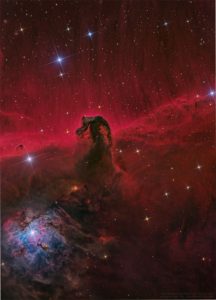The PROMPT telescopes built by the Physics and Astronomy department of UNC – Chapel Hill at Cerro Tololo Inter-American Observatory (CTIO) in Chile, have secured a coveted spot on NASA’s Astronomy Picture of the Day (APOD). The featured image, showcasing the ethereal Horsehead Nebula, is credited to Mark Hanson and Martin Pugh from SSRO, PROMPT, CTIO, NSF.
The Horsehead Nebula, residing approximately 1,500 light-years away within the expansive Orion cloud complex, has been sculpted over time by stellar winds and radiation. Standing at about five light-years in height, this interstellar dust cloud, cataloged as Barnard 33, captivates with its distinctive equine profile. Its silhouette becomes visible against the backdrop of the red emission nebula IC 434, thanks to the dust’s obscuring effect.
The image also reveals ongoing star formation within the dark cloud, adding another layer of astronomical significance. Adjacent to the Horsehead Nebula, a contrasting blue reflection nebula identified as NGC 2023 can be seen. This nebula surrounds a young, hot star and occupies the lower left portion of the complete image.
Mark Hanson and Martin Pugh utilized a combination of narrowband and broadband imaging techniques with several telescopes to create this breathtaking color image. The result is a visual masterpiece that not only captures the mesmerizing beauty of the Horsehead Nebula but also highlights the intricate details of the surrounding cosmic landscape.
The recognition on NASA’s APOD platform underscores the contribution of UNC’s Physics and Astronomy department to the exploration and understanding of our vast and fascinating universe.
About PROMPT telescopes:
PROMPT, an acronym for Panchromatic Robotic Optical Monitoring and Polarimetry Telescopes, is being built by the University of North Carolina at Chapel Hill at Cerro Tololo Inter-American Observatory (CTIO) in Chile.
PROMPT’s primary mission revolves around swiftly conducting simultaneous multiwavelength observations of gamma-ray burst afterglows, often capturing them mere tens of seconds after their inception. Beyond this, PROMPT will meticulously measure redshifts through dropout techniques, analyse early-time Spectral Energy Distributions (SFDs), and delve into extinction curves of particularly luminous afterglows with unparalleled precision. The telescope’s versatility extends to facilitating prompt response observations at prominent observatories, including the UNC-led 4.1-m SOAR Telescope. In a notable dual role, PROMPT is poised to serve as an educational platform for both undergraduate and high school students across the State of North Carolina.
For more information, please visit – https://noirlab.edu/public/programs/ctio/


